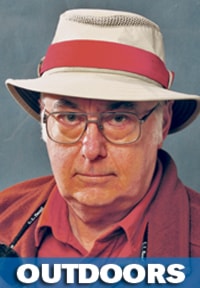In the soon to be 49 years of these weekly columns, they have appeared for varying periods in a dozen Alberta newspapers.
I’ve always negotiated a complimentary subscription as part of the fee with the weekly newspapers to keep the column in tune with the communities and to benefit from occasional column subjects.
The headline on a story taking up half the front page of the Jan. 13, 2015, edition of The Brooks Bulletin really rattled my rafters: Family, friends celebrate Blanche Coultis’ 100th birthday.
Brooks is my home town, and Miss (now Ms.) Coultis was one of possibly the finest high school staffs ever assembled in any Alberta small town. Principal Frank Riddle, who taught Math 30, had a MSc., Barry Munro, Chemistry, Physics, Math 31, etc., had a BEd and a BSc., Lorin Mair, English, had a MFA from Mount Allison, where he had studied under the late, great Canadian painter, Alex Colville.
In addition to the venerable “Normal School” qualifications, Ms. Coultis held a BA from the U of A and an MA from McGill in 1949 in French Language and Literature.
In mid-1950s Alberta, few high school students hoping for university admission had the benefit of dealing with French 20 and 30 with a teacher who actually spoke the language.
The benefit to me of Ms. Coultis’s excellent instruction was sufficiently good marks in first year French at U of A that my professors talked me out of the two-year pre-law course and into the four-year Honours in French and English program.
The decision was made easier by the fact that if I continued with the five-year BA-LLB course, I would have been too young to be admitted to the bar when I graduated and would have had to article an extra year for peanuts.
Blanche Coultis was born on a homestead at Steveville, along the Red Deer River, and was vitally interested in the human and natural histories of the area.
In the mid–’50s, she took several of her students in her motor boat on a trip downriver to and through the area that was about to become Dinosaur Provincial Park, and guided us ashore up canyons with big fossil bones jutting everywhere.
At the base of every gully were shards and relics; from one of these, I kept a perfect, serrated shark’s tooth. From that amazing day I remember pushing the boat grounded in the very shallow river, a sandstorm or several in mid-river and, always, the sound of the land eroding.
Years later, in Halifax, my ancient landlord, George Farquhar, who among several distinguished careers, had been editor of The Chronicle Herald and The Mail Star, broke his elk tooth watch fob. “How’d you like a fossilized shark’s tooth instead?” I asked.
Yet again he expressed the view that Westerners were full of … hyperbole. Back from a summer in the West for my last year of law school, I gave Mr. F. my tooth and he promised to quit hyping his Westerner stuff.
I had spent that summer working in that lower Red Deer-South Saskatchewan River Country, where elk teeth were scarcer than hen’s and it had become illegal to collect fossils from Dinosaur Park.
Now elk and their teeth are far too numerous on and in the vicinity of Canadian Forces Base Suffield and there is great reader interest for and against the efforts being made to reduce the elk numbers and protect neighbouring farmers and ranchers from the damage they cause.
Official numbers have yet to be announced, but one reader says an official connected with the hunt told him they got a 90 per cent kill from the 300 hunters in November.
Frantic drawing has been going on from thousands of applications for two three-day seasons in February, each of which will have 125 licensed hunters with two cow elk tags each.
In addition, there has been a native hunt going on that is causing controversy, with other hunters claiming the natives are the only hunters apparently permitted to harvest the superb trophy bull elk on the military reserve. Generally our natives can hunt for food on land to which they have a legal right of access without regard to most provincial game laws.
But, it seems to me, you could impose “no bulls” as a condition of granting access.
Whatever, there is a picture circulating in cyberspace of an alleged native truckful of elk antlers captioned: “Not to worry, they only hunt for food!”
Many hunters are refusing to participate, calling it “butchery” to hunt pregnant elk in February; “even cows that are not shot will abort from being chased around in this Grand Prix of road hunts,” says one reader. One problem is we are inured to butchery in Alberta: we poison and strafe 1,000 wolves and all other wildlife in the Little Smoky River area to avoid stopping the habitat destruction that really kills our caribou.
Another problem is that we’re going to have to kill between 1,200 and 1,600 cows just to stay even with the out-of-control CFB Suffield elk herd.
Bob Scammell is an award-winning columnist who lives in Red Deer. He can be reached at bscam@telusplanet.net.
